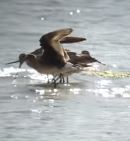Hudwit visits the Flying Doctor?
When I was growing up in England one of the staples of the radio was a drama series about the Flying Doctor. I can't remember a great deal about it (and Uncle Google is surprisingly deficient in this matter) but Bill Kerr played the pilot. A frequent occurrence was him calling the airstrip they left from with the words "Flying Doctor calling Wollumboola Base ...".
Finally we get close to the main part of this post! It is not about "Wollumboola Base" per se, but Wollumboola Lake. The former is somewhere rather remote (I always think of it as being near Alice Springs) while the latter is on the coast East of Nowra and South of the Shoalhaven ....
Here is a Fairy Tern coming in to land.
Eventually some of the smaller birds started coming over to feed near us. They were very skittish.
The terns continued to provide interest. This gives a nice contrast between a Caspian Tern and the Fairy and Little Terns
Red-capped Plovers were reasonably abundant (and, this one at least, very cooperative).
Red-necked stints were in profusion.
So were Sharp-tailed Sandpipers.
One observer took one for the team by wading out about 150m. His ethics wouldn't let go and stir the massive flock on the sandbar - the flock is visible as a dirty line on the water - into flight. He was out there when a White-bellied Sea-eagle appeared and spooked a few Godwits into coming nicely closer.
As they flew some observers reckon they saw a black underwing so we all rushed off to the closest point we could reach and spent the next hour peering into our various forms of optical gear.
Finally we get close to the main part of this post! It is not about "Wollumboola Base" per se, but Wollumboola Lake. The former is somewhere rather remote (I always think of it as being near Alice Springs) while the latter is on the coast East of Nowra and South of the Shoalhaven ....
.. and thus quite accessible to Canberra.
We visited this area in October this year (2015) and quite enjoyed it so when a Hudsonian Godwit turned up at the Lake (the first in NSW since about 1982) I thought it worthwhile investing a few litres of diesel in going to view it. This is the third Godwit species possible in the area and the name is often shortened to Hudwit, while the other two species are referred to as the Barwit (Bar-tailed Godwit) or Blackwit (Black-tailed Godwit).
The 2.5hr drive down was uneventful, although my wrath was stirred by the inactivity of Palerang Shire in putting a 60kph limit on 5kms of the Oallen Ford Rd while they think about the possibility of considering the concept of fixing the road. Once in the village of Culburra Beach, at 11am, the road signs got a tad prophetic:
There were a few other birders around ...
... and two of them explained that all the waders were on a sandbar out in the middle of the Lake. They had been told that at 7:30 the Hudwit was feeding right on the shore. It wasn't now, and neither were any other 'wits. The water birds nearby were Great, Little Black and Little Pied Cormorants, Silver Gull, Chestnut Teal, Crested Tern and Fairy Terns (the two small jobbies with their heads turned away).Here is a Fairy Tern coming in to land.
Eventually some of the smaller birds started coming over to feed near us. They were very skittish.
The terns continued to provide interest. This gives a nice contrast between a Caspian Tern and the Fairy and Little Terns
Red-capped Plovers were reasonably abundant (and, this one at least, very cooperative).
Red-necked stints were in profusion.
So were Sharp-tailed Sandpipers.
One observer took one for the team by wading out about 150m. His ethics wouldn't let go and stir the massive flock on the sandbar - the flock is visible as a dirty line on the water - into flight. He was out there when a White-bellied Sea-eagle appeared and spooked a few Godwits into coming nicely closer.
As they flew some observers reckon they saw a black underwing so we all rushed off to the closest point we could reach and spent the next hour peering into our various forms of optical gear.
One bird seemed very like the Hudwit and I followed it with my scope for about 20 minutes. Then it raised its wings: as white as driven snow. Far Canal! Blackwit. Every other one that raised its wings had speckled underwings - Barwit, as usually then confirmed by displaying a barred tail!
I refer readers to the first image above.
What we were after was a very dark underwing like this:
The image was snipped from the end of a video in this You-tube taken by my friend Alastair Smith.
















Comments